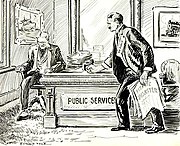Before the survivors even arrived in New York, investigations were being planned to discover what had happened, and what could be done to prevent a recurrence. The United States Senate initiated an inquiry into the disaster on 19 April, a day after Carpathia arrived in New York.
The chairman of the inquiry, Senator William Alden Smith, wanted to gather accounts from passengers and crew while the events were still fresh in their minds. Smith also needed to subpoena the British citizens while they were still on American soil. This prevented all surviving passengers and crew from returning to England before the American inquiry, which lasted until 25 May, was completed.
Lord Mersey was appointed to head the British Board of Trade's inquiry into the disaster. The British inquiry took place between 2 May and 3 July. Each inquiry took testimony from both passengers and crew of the Titanic, crew members of Leyland Line's Californian, Captain Arthur Rostron of the Carpathia and other experts.
The investigations found that many safety rules were simply out of date, and new laws were recommended. Numerous safety improvements for ocean-going vessels were implemented, including improved hull and bulkhead design, access throughout the ship for egress of passengers, lifeboat requirements, improved life-vest design, the holding of safety drills, better passenger notification, radio communications laws, etc. The investigators also learned that the Titanic had sufficient lifeboat space for all first-class passengers, but not for the lower classes. In fact, most third-class, or steerage, passengers had no idea where the lifeboats were, much less any way of getting up to the higher decks where the lifeboats were stowed.
SS Californian inquiry
Both inquiries into the disaster found that the SS Californian and its captain, Stanley Lord, failed to give proper assistance to the Titanic. Testimony before the inquiry revealed that at 22:10, the Californian observed the lights of a ship to the south; it was later agreed between Captain Lord and Third Officer C.V. Groves (who had relieved Lord of duty at 22:10) that this was a passenger liner. The Californian warned the ship by radio of the pack ice because of which the Californian had stopped for the night, but was violently rebuked by Titanic senior wireless operator, Jack Phillips. At 23:50, the officer had watched this ship's lights flash out, as if the ship had shut down or turned sharply, and that the port light was now observed. Morse light signals to the ship, upon Lord's order, occurred five times between 23:30 and 01:00, but were not acknowledged. (In testimony, it was stated that the Californian's Morse lamp had a range of about four miles (6 km), so could not have been seen from Titanic.)[32]
Captain Lord had retired at 23:30; however, Second Officer Herbert Stone, now on duty, notified Lord at 01:15 that the ship had fired a rocket, followed by four more. Lord wanted to know if they were company signals, that is, coloured flares used for identification. Stone said that he did not know that the rockets were all white. Captain Lord instructed the crew to continue to signal the other vessel with the Morse lamp, and went back to sleep. Three more rockets were observed at 01:50 and Stone noted that the ship looked strange in the water, as if she were listing. At 02:15, Lord was notified that the ship could no longer be seen. Lord asked again if the lights had had any colours in them, and he was informed that they were all white.
The Californian eventually responded. At 05:30, Chief Officer George Stewart awakened wireless operator Cyril Evans, informed him that rockets had been seen during the night, and asked that he try to communicate with any ships. The Frankfurt notified the operator of the Titanic's loss, Captain Lord was notified, and the ship set out for assistance.
The inquiries found that the Californian was much closer to the Titanic than the 19.5 miles (31.4 km) that Captain Lord had believed and that Lord should have awakened the wireless operator after the rockets were first reported to him, and thus could have acted to prevent loss of life.[32]
In 1990, following the discovery of the wreck, the Marine Accident Investigation Branch of the British Department of Transport re-opened the inquiry to review the evidence relating to the Californian. Its report of 1992 concluded that the Californian was farther from the Titanic than the earlier British inquiry had found, and that the distress rockets, but not the Titanic herself, would have been visible from the Californian.[53]





0 comments:
Post a Comment